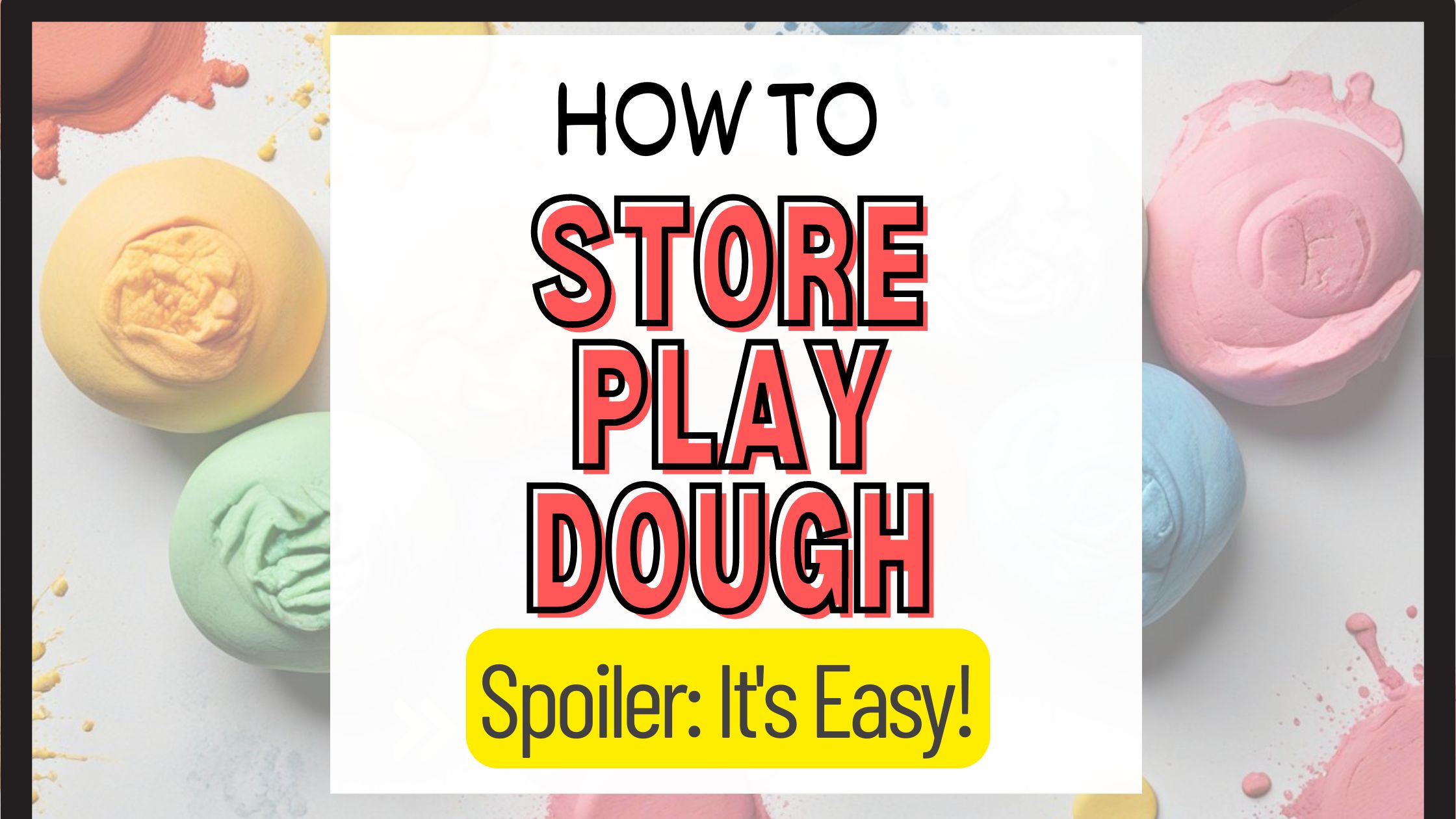Creating handmade sensory dough is a fun and engaging activity for both kids and parents alike. However, one common challenge many face is how to make this dough last longer. Today, we’re diving deep into some foolproof methods to extend the life of your sensory dough, ensuring your little ones can enjoy it for weeks to come! 🌟
Why Does Sensory Dough Dry Out? 🤔
Before we get into how to keep your dough fresh, it’s important to understand why it dries out in the first place. Most homemade doughs are made with basic ingredients like flour, water, salt, and sometimes cream of tartar. Over time, moisture evaporates from the dough, causing it to become dry and brittle. The salt content, while acting as a preservative, can also accelerate this process if the dough is left uncovered or stored improperly.
Moisture is key to keeping your sensory dough soft and pliable. By retaining moisture, you can extend the life of your dough and keep it fresh for weeks—if not months! Here are my tried-and-true tips to make that happen. 🕒

1. Store It Properly 🛒
The most crucial step in keeping your dough fresh is storing it the right way. Airtight containers are your best friend here! Here’s how to do it:
- Use Airtight Containers: After playtime, make sure to store your dough in an airtight container. Ziplock bags work great too, but containers are easier to stack and store. Make sure you press out all the air before sealing. You can use all the empty baby food jars like me. Just make sure to sterilize them first.
- Keep It in the Fridge: While it’s not necessary, refrigerating your sensory dough can extend its life by keeping it cool and reducing the evaporation rate. Plus, cool dough can add an extra sensory element to playtime! ❄️
- Avoid Direct Sunlight: Store your dough in a cool, dark place. Direct sunlight can cause the dough to dry out faster by speeding up the evaporation process. 🚫🌞
2. Add Moisture Regularly 💧
No matter how well you store your dough, it will lose some moisture over time. But don’t panic—there’s an easy fix!
- Knead in Water: If you notice your dough is starting to get dry, simply knead in a few drops of water. Start with a little and gradually add more until the dough is back to its soft, pliable self. Remember, a little water goes a long way!
- Use Vegetable Oil: For an extra smooth texture, you can also knead in a tiny bit of vegetable oil. This not only helps retain moisture but also makes the dough less sticky and easier to clean up. 🌟
- Wrap in a Damp Cloth: If you’re storing the dough for an extended period, consider wrapping it in a damp cloth before placing it in an airtight container. This will help maintain its moisture levels even longer.
3. Revive Old Dough with a Simple Trick 🧙♂️
What if your dough has already dried out? Don’t throw it away just yet! Here’s how you can revive it:
- Steam It: Place the dough in a microwave-safe bowl with a damp cloth over it, and microwave for about 10-20 seconds. The steam will rehydrate the dough, making it soft and pliable again. Just be careful—it might be hot, so let it cool before handing it to your kids! 🔥
- Hot Water Bath: Another method is to place the dough in a bowl and slowly pour hot water over it, little by little. Knead the dough as you go to help it absorb the moisture. Once it’s back to the right consistency, store it properly, and it should last for more play sessions.
4. Add Natural Preservatives 🌿
You can naturally extend the life of your sensory dough by adding ingredients that help preserve it:
- Vinegar or Lemon Juice: Adding a small amount of vinegar or lemon juice to your dough recipe can act as a natural preservative. This helps keep bacteria at bay, ensuring your dough stays fresh longer. Plus, it gives the dough a pleasant scent! 🍋
- Salt: While salt is already a key ingredient in most dough recipes, adding a bit more can help preserve the dough. Just be cautious—too much salt can make the dough dry out faster, so balance is key!
5. Customize Your Dough with Essential Oils 🌸
Essential oils not only add a lovely fragrance but also have antimicrobial properties that can help your dough last longer. (I will mention here that essential oils are dangerous for very young kids -my doctor said) Here’s how to do it:
- Lavender or Tea Tree Oil: A few drops of lavender or tea tree oil will give your dough a calming scent while also acting as a natural preservative. Lavender is great for relaxing playtime, while tea tree oil’s antiseptic properties keep the dough fresh. 🌿
- Peppermint or Eucalyptus: These oils can give your dough a refreshing, energizing scent while also helping to keep bacteria and mold away. Perfect for invigorating play sessions! 🍃
For more ideas on how to make sensory play even more engaging, check out my post on Top 31 Sensory Dough Activities You Have to Try with Your Kids. 🎨
How to Make Handmade Sensory Dough Last Longer Without Cream of Tartar 🧂
Many sensory dough recipes call for cream of tartar, which acts as a stabilizer and preservative. But what if you don’t have it on hand? No worries! Here are some alternatives:
- Lemon Juice: As mentioned earlier, lemon juice is a great substitute for cream of tartar. It helps strengthen the dough and keeps it from becoming too sticky. 🍋
- Vinegar: Vinegar works similarly to lemon juice, adding acidity to the dough, which helps preserve it and maintain its elasticity.
- Baking Soda: While not a perfect substitute, a small amount of baking soda can also help stabilize the dough, especially when combined with vinegar or lemon juice.
Experimenting with different recipes is half the fun of making sensory dough.
For some inspiration on salt dough activities, check out The Simple Guide to Teaching Math with Sensory Dough—a must-read for parents looking to turn playtime into a learning experience! 📚
Frequently Asked Questions 🤔
1. How long does handmade sensory dough last?
With proper storage and care, handmade sensory dough can last anywhere from a few weeks to a couple of months. If you follow the tips above, you can extend its life significantly! 📅
2. Can you refrigerate sensory dough?
Yes, refrigerating sensory dough can help it last longer by slowing down the evaporation process. Just make sure it’s stored in an airtight container to prevent it from drying out.
3. What can I do if my sensory dough gets too sticky?
If your dough becomes too sticky, try adding a bit more flour or cornstarch and knead it in until you reach the desired consistency. You can also try adding a little bit of vegetable oil. 🌽
4. How do you keep sensory dough from drying out?
Store it in an airtight container, keep it away from direct sunlight, and add moisture as needed. Wrapping it in a damp cloth before storing can also help retain moisture.
5. Can you add food coloring to sensory dough?
Absolutely! Food coloring is a fun way to make your sensory dough more visually appealing. Just be sure to knead it in well to avoid staining hands or surfaces. For more colorful sensory play ideas, explore Nature Sensory Bottle Ideas.rtant as the finished craft. Enjoy every squishy, sticky, glittery moment!
6. How to keep homemade playdough from molding?
Avoid Humidity: Keep the playdough in a cool, dry place. Humid environments can promote mold growth, so storing it in a dry area is essential.
Clean Hands and Surfaces Before Use 🧼 Before your kids start playing with the dough, ensure that their hands and the surface they’re working on are clean. This reduces the introduction of bacteria and mold spores into the dough.
Avoid Contamination 🚫
- Don’t Mix with Food: Sometimes kids like to pretend to “cook” with their playdough. However, mixing playdough with food or crumbs can introduce mold spores.
- Regularly Inspect the Dough: Check the playdough regularly for any signs of mold. If you notice any discoloration or an off smell, it’s best to discard it and make a fresh batch.
Dry It Out Between Uses 🌬️ If you’re not planning to use the playdough for a while, consider leaving it out to dry before storing it. Dry playdough is less likely to develop mold, and you can always add a bit of water or oil to rehydrate it before the next use.
Final Thoughts: Keep the Fun Going Longer! 🎉
There’s nothing quite like the joy of seeing your little one dive into a fresh batch of sensory dough. By following these tips and tricks, you can ensure that your handmade dough stays soft, pliable, and ready for play, time after time. Remember, the key to long-lasting dough is all about moisture retention and proper storage. 🌟
For more sensory play ideas, check out Sensory Bin Ideas with Household Items and start creating endless fun with items you already have at home! 🏠
Have any other tips for keeping sensory dough fresh? Share them in the comments below—I’d love to hear what works for you! 👇
Pin it for Later

📌 Pin now, read later! Save our guide on Pinterest and share the joy of sensory play with your friends and family.
Ready to dive into even more sensory fun? Explore our collection of sensory bin ideas and see how you can combine them with your fresh, long-lasting dough for the ultimate play experience! 🧡 Check it out here.
Latest Posts:
THE Cutest Toddler Scribble Father’s Day Cards (Simple & Sweet !)
Looking for a cute Father’s Day Card With Toddler Scribbles? This Father’s Day card is…
Easy DIY Father’s Day Card with Real Roses (From Toddlers)
This year, I wanted to create a super simple craft with my 1-year-old, Luca, to…
21+ Easy Father’s Day Coloring Pages Printable: (Free Download!)
Looking for a sweet, easy way for kids to show Dad some love this Father’s…
Easy Sticker Wall + Scribble Zone for Toddlers: Creative and Mess-Free
✨ A Simple Idea That Sparked Big Creativity The idea for this activity came from…
Simple and Fun Animal Walks for Toddlers: Boost Core Strength with Outdoor Gross Motor Play
I hated school sports. I am short, have bad eyesight and was always the last…
Arctic Ocean Sensory Bin DIY — The One Sensory Bin You Need to Try This Week
Creating an Arctic Ocean sensory bin has easily been one of our favorite indoor toddler…














